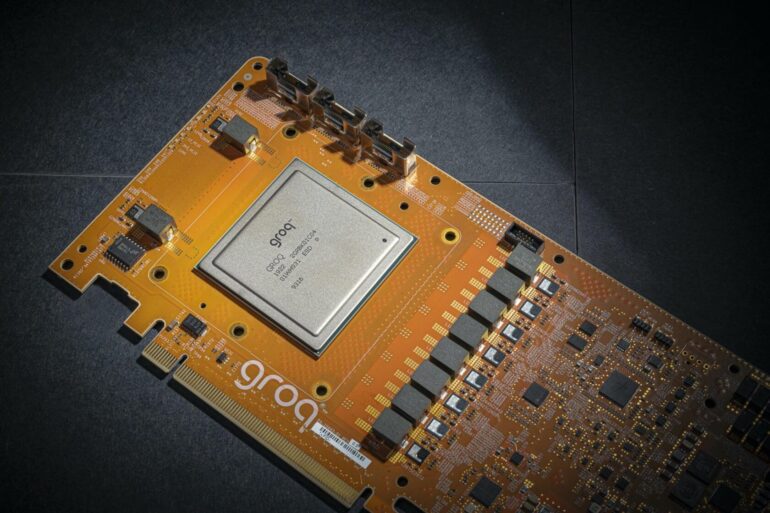TL;DR:
- Groq aims to deploy 1 million AI inference chips within two years.
- The company’s GroqChip LPUs offer an alternative to Nvidia GPUs for AI inference.
- Groq’s unique technology doesn’t depend on HBM memory or advanced packaging, giving it a competitive advantage.
- Groq’s approach focuses on solving real, unsolved problems for customers.
- Benchmarking shows Groq’s 100X better price/performance compared to Nvidia GPUs.
- The roadmap includes scalable solutions and improved power efficiency.
- Groq’s innovations are poised to reshape the AI hardware market.
Main AI News:
In the ever-evolving landscape of artificial intelligence, the demand for efficient inference solutions has never been higher. Groq, a trailblazer in this field, is poised to disrupt the market with its Language Processing Units, or LPUs, popularly known as the GroqChip. The company is gearing up for a massive production surge, aiming to deploy a staggering one million AI inference chips within the next two years. This ambitious goal reflects Groq’s commitment to meeting the surging demand for large language models.
The Current AI Hardware Landscape
The rapid rise of generative AI has prompted a search for alternatives to Nvidia GPUs, as the supply of these GPUs struggles to keep pace with soaring demand. A slew of innovative compute engines, including the CS-2 wafer-scale processor from Cerebras Systems, the SN40L Reconfigurable Dataflow Unit from SambaNova Systems, and Intel’s Gaudi 2 and Gaudi 3 engines, have gained traction as viable options. What sets GroqChip LPUs apart is their independence from HBM memory and advanced packaging technologies like CoWoS, giving them a competitive edge.
Efficiency Beyond Advanced Processes
Groq draws inspiration from machines like China’s “OceanLight” supercomputer, which relies on homegrown SW26010-Pro processors etched with 14-nanometer processes. This example proves that advanced processes and packaging aren’t prerequisites for building high-performance compute engines. Groq’s co-founder and CEO, Jonathan Ross, believes that Groq LPUs can outperform Nvidia GPUs in terms of throughput, latency, and cost for large language model inference.
Solving Real Problems
One might wonder why Groq faced challenges in gaining market traction. According to Ross, the key was not technical readiness or tuning AI models for their chips. The crux lay in addressing real, unsolved problems faced by potential customers. Groq initially approached customers with solutions that could lower costs or accelerate processes, only to find that many considered their existing setups sufficient. However, the tide turned when the demand for running increasingly complex models outpaced the capabilities of current hardware. Now, Groq finds itself in high demand, with hardware allocation becoming a contentious issue.
Groq’s Vision for Commercial-Grade Inference
Groq’s proposition for commercial-grade inference with sub-second response times on large language models involves using pods of GroqChips with optical interconnects. These pods can scale up to 264 chips, with the potential for further scaling through the addition of switches. In the next generation, Groq envisions clusters with 4,128 GroqChips on a single fabric. This scalability is set to improve with the introduction of the next-generation GroqChip in 2025, etched in Samsung’s 4-nanometer processes.
Benchmarking Success
Groq’s benchmarking efforts are nothing short of impressive. They linked 576 GroqChips to run inference against the LLaMA 2 model from Meta Platforms, scaling up to a remarkable 70 billion parameters. In comparison, Nvidia H100 GPUs took ten times longer and cost ten times as much to achieve similar results. Groq’s approach offers 10 times the speed of inference at one-tenth the cost, translating to a 100-fold improvement in price/performance.
The Path Forward
Groq’s roadmap includes the deployment of 100,000 LPUs in twelve months and an ambitious target of 1 million LPUs in 24 months. As organizations seek alternatives to proprietary AI models, Groq’s efficient and scalable solutions are poised for widespread adoption. The forthcoming next-generation GroqChip promises to further enhance power efficiency, potentially reducing the number of chips required to accomplish complex tasks. Meanwhile, a new node with increased chip density is set to offer cost, power, and latency benefits.
Conclusion:
Groq’s commitment to delivering unparalleled efficiency in AI inference is reshaping the industry. With a clear focus on solving real problems and a roadmap for continuous improvement, Groq is well-positioned to revolutionize the AI hardware landscape. As the demand for large language models continues to soar, Groq’s innovative solutions are poised to play a pivotal role in shaping the future of AI inference.

